Artists’ Studios in Paris Digitally Mapping the 18th-Century Art World
- Hannah Williams
Paris, perhaps more than any other city, is renowned for the artistic communities that have inhabited its streets and quartiers. From Montmartre to Montparnasse, Paris’s neighborhoods have played definitive roles in the narratives of nineteenth- and twentieth-century art history, as urban environments where art practice evolved through relationships between local people and city spaces.1 Yet, when it comes to eighteenth-century art history, the city has been far less present. Despite our field’s concerns with networks of artistic sociability or the collaborative nature of so much eighteenth-century art production, and despite the emergence in this period of an artistic engagement with city life and space—for instance, in street scenes like Philibert-Louis Debucourt’s View of the Louvre and Rue Frementeau (Fig. 1)—we have looked strikingly little at how these earlier generations of French artists inhabited the city. Where in Paris did eighteenth-century artists live and work? Which artists were neighbors? What sub-communities formed within the city? Who preferred to live far away from their colleagues? Which neighborhoods formed the cultural geography of the eighteenth-century art world? And did that geography change over the course of the century?

Artists in Paris: Mapping the 18th-Century Art World is a digital mapping project that began as an effort to answer these seemingly straightforward, yet nevertheless perplexing, questions. Following original archival research to find the addresses of eighteenth-century artists, I built a database containing biographical and demographic data for every artist who was a member of the Académie Royale de Peinture et de Sculpture between 1675 and 1793. Tracing an address for every year of their academic careers, this generated a dataset of almost 11,000 addresses for nearly 500 artists over a 118-year period. Next, working with eighteenth-century maps of Paris and open source software (including Map Warper, GeoJSON, and OpenStreetMap), I created georeferenced historical maps of the city and determined longitude and latitude coordinates for each of the artist’s addresses. The final stage of the project was undertaken with a web developer, Chris Sparks (Queen Mary University of London), to develop a website of interactive maps (using OpenLayers) that make this demographic data accessible and searchable online for research and teaching.
Though this digital history project began as an experimental gambit, the archival research into the locations of artists’ studios and the visualization of that data on eighteenth-century maps of the city has satisfyingly achieved its original objectives. Artists in Paris can now tell us where hundreds of Paris’s artists lived and worked, revealing patterns and shifts over time, or the personal trajectories of individuals around the city. In short, these data-rich digital maps have gone a long way to answering those initial questions. More unexpected, however, are the new questions that have opened up as a result of these answers, and the exciting possibilities for eighteenth-century studies promised by cartographic modeling and the terrain of a spatial art history more generally.2 From a starting point in the history of Paris’s artistic communities, the processes involved in digital mapping have led me deeper into the history of the city itself, and the points of intersection between urban history and art history, to pose new lines of inquiry. What would a city-centered investigation of eighteenth-century French art look like? What role did city space and urban experience play in art’s production and reception? And what aspects of the eighteenth-century art world survive in the urban fabric of the contemporary city?
Reflecting on the paths taken through this project, in this article I consider the processes involved in the development of Artists in Paris, not only to suggest what the maps have already revealed about the geography and demography of the eighteenth-century Paris art world, but also to contemplate some of the alternative art-historical terrains to which they might yet lead. Beginning with an examination of the project’s research and development stages, and the challenges faced along the way (challenges both specific to this project and more generally for art historians working with digital humanities methods), this article goes on to analyze maps and data from the website to offer some preliminary findings and potential avenues for further research. Finally, prompted by the layers of urban art history embodied virtually in the website’s georeferenced maps, I conclude by following one of those avenues, to seek out traces of the eighteenth-century art world in the urban environment of Paris today.
Mapping Paris: A Digital Art History Project
Inspired by those intriguing questions about where eighteenth-century artists lived and worked in Paris, from the outset this digital mapping project had three clear objectives: to find primary sources that recorded the locations of artists’ homes and studios and to extract that information into a useable form; to plot these addresses on georeferenced historical maps of the city; and to make this data available online through an interactive platform. These objectives also break down into the different stages of the project’s development, which I will consider here in turn.
Retrieving the addresses of every eighteenth-century artist working in Paris proved at once straightforward and impossible. On one hand, if limited to the artists who were members of the Académie Royale (the city’s foremost art institution, founded in 1648), finding primary sources recording artists’ addresses was not difficult, given the bureaucratic nature of the institution and the elite status these artists held during their lifetimes. On the other hand, if expanded to include other artists, such as the painters and sculptors of the Guild (the much older medieval corporation of master artists in Paris), or anyone involved in the city’s other artistic trades, the task would have been vast, both in terms of defining the parameters of who to include or exclude, and then finding the relevant address information for members of often less archivally-minded artistic communities. Quickly it became evident that focusing solely on the Academy’s artists would yield the most complete dataset. While this choice circumscribed the social scope of the artistic community featured in the website’s demographic data, the Academy’s artists nevertheless constitute a substantial population, while also being the most prominent agents in art histories written about this period and so arguably the most interesting subjects for a study of this kind. Needless to say, however, comparable mapping projects devoted to the Guild artists or other art-world groups (other kinds of artists or artisans, colormen, art supplies traders, picture restorers, art dealers, etc.) would make for fascinating comparative analysis, as efforts in that direction have already suggested.3
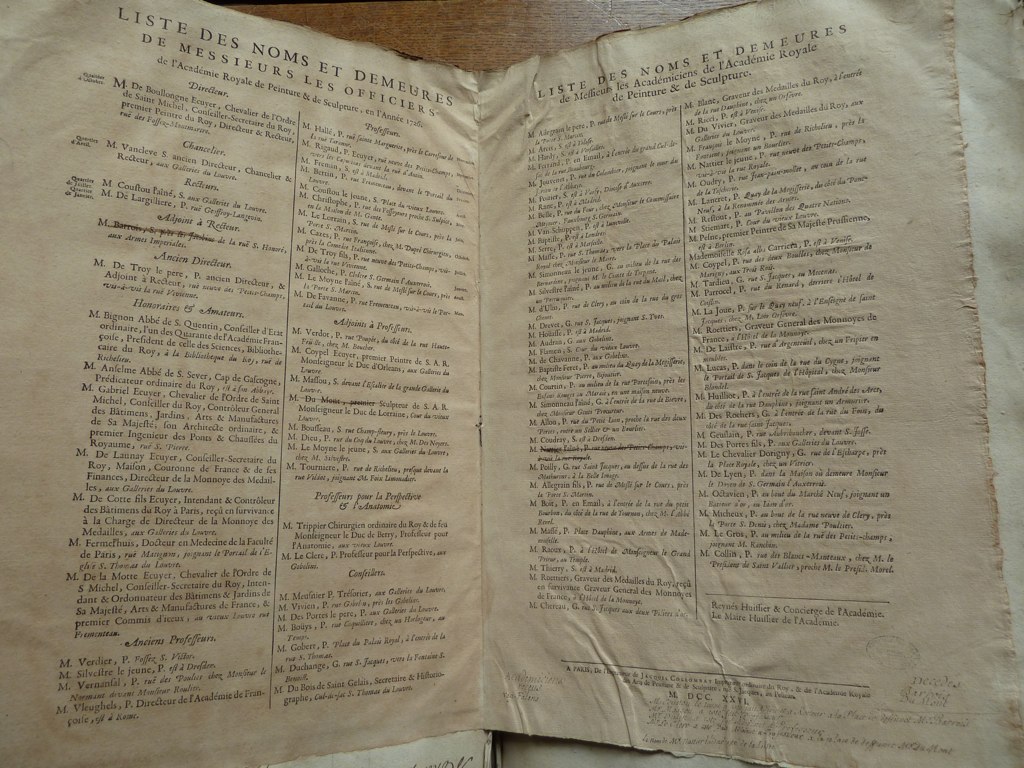
Through a combination of sources, including the Academy’s own membership lists kept by the institution’s concierge (now in the archives of the École nationale supérieure des beaux-arts, Paris) (Fig. 2) and the academicians’ addresses published annually in the Almanachs Royaux (or Almanachs Nationaux following the Revolution), it has been possible, with some minor exceptions, to retrieve addresses for every artist at the Academy between 1675, when the concierge began keeping his lists, and 1793, when the institution was disbanded during the Revolution.4 From the information in these documents (fleshed out with additional research into artists’ biographical details like birth and death dates, place of birth, year of admission to the Academy, etc.), I populated a relational database in Filemaker Pro containing individual entries for 471 people (the number of artists who were members of the institution within this timeframe), with an address record for every year during which they were a member—that is, from their réception (admission) until their death—which comes to a total of 10,918 addresses (some of them repeated if artists lived at the same address for several years).
Visualizing this demographic data in a cartographic format was challenging for many reasons. Given the significant urban transformations that Paris has experienced since the eighteenth century, it would be meaningless in many cases to plot the artists’ addresses on contemporary maps. An early experiment plotting the Academy’s address list from 1726 (Fig. 2) in Google Maps showed, for instance, that while a contemporary map was sufficient for an artist like Nicolas de Largillière living on Rue Geoffroy-Langevin (Fig. 3), a street that still exists today, it would make little sense for an artist like Nicolas Bertin, who lived on Rue Frementeau, a street that has long since disappeared. Depicted in Debucourt’s painting (Fig. 1), Rue Frementeau was destroyed in the nineteenth century to make way for the expansion of the Musée du Louvre, so on contemporary maps its location is now marked by the glass pyramid of the Cour Napoléon (Fig. 4).

To overcome these temporal urban disjunctions, the solution was to use historical maps instead of contemporary ones, so that the eighteenth-century addresses can be plotted on eighteenth-century streets.5 Generating digitally useable versions of eighteenth-century maps involves a process called georectification, in which a digital image of the map is embedded with spatial reference information, like longitude and latitude coordinates.6 Cartographic precision in the original map is essential for successful georectification, so after experimenting with numerous eighteenth-century maps of Paris, I decided to work with two of the most geographically accurate, both from the later decades of the century: Jean Junié’s Plan des paroisses de Paris (1786) (Fig. 5) and Edmé Verniquet’s Plan de la Ville de Paris (1790) (Fig. 6).7 Using high resolution digital scans of these maps, the next step was to georectify them using Map Warper, an open source tool for georectification and georeferencing. By identifying a series of control points connecting locations on the digitized historical map with locations on the contemporary base map (in this case OpenStreetMap), Map Warper uses these links to “warp” or align the historical map to the co-ordinates of the base map (the process is captured in Fig. 7). The georeferenced versions of the historical maps can then be exported in various formats (GeoTiff, PNG, KML, WMS, or Tiles) for use in other mapping applications.
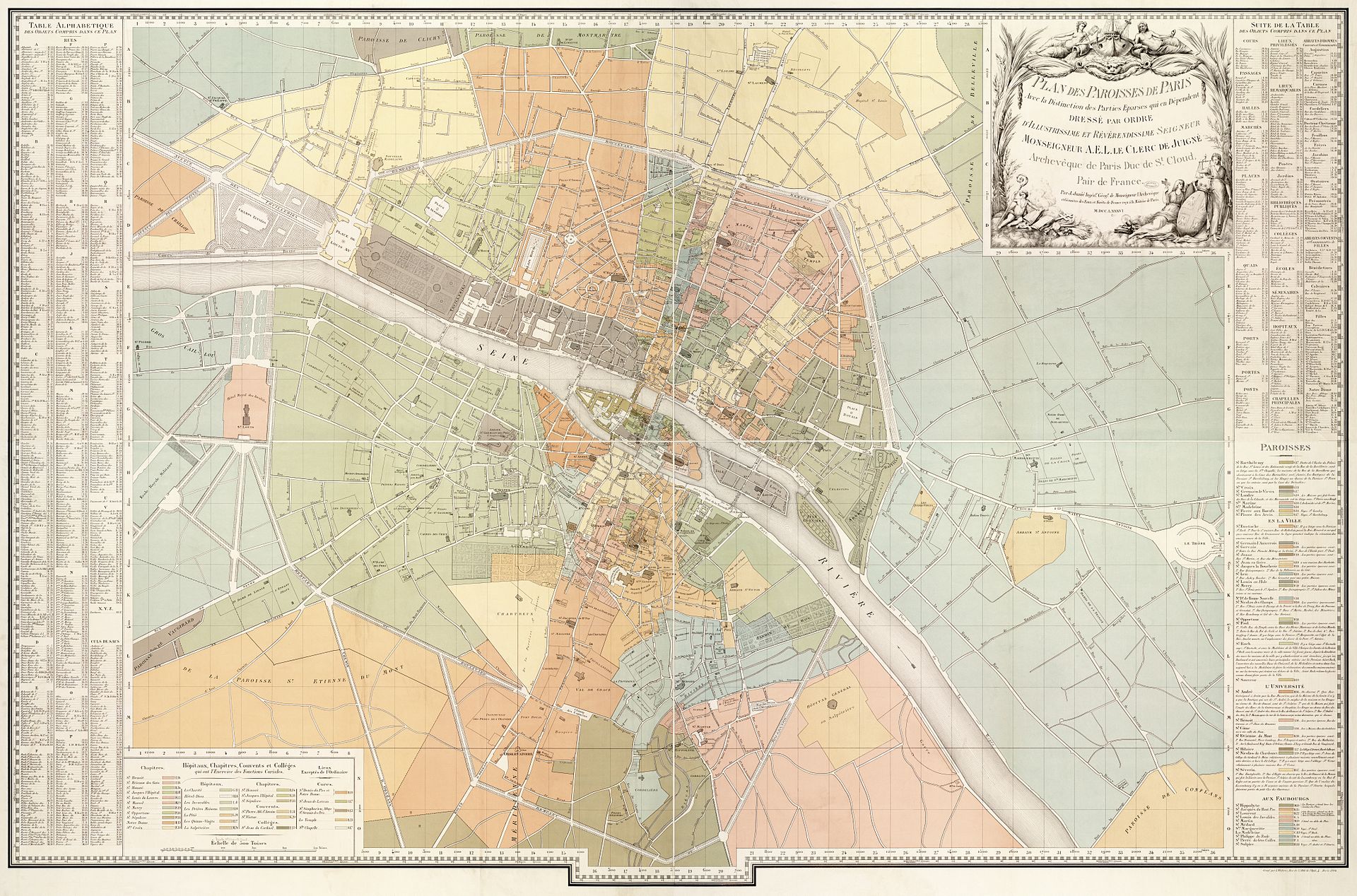
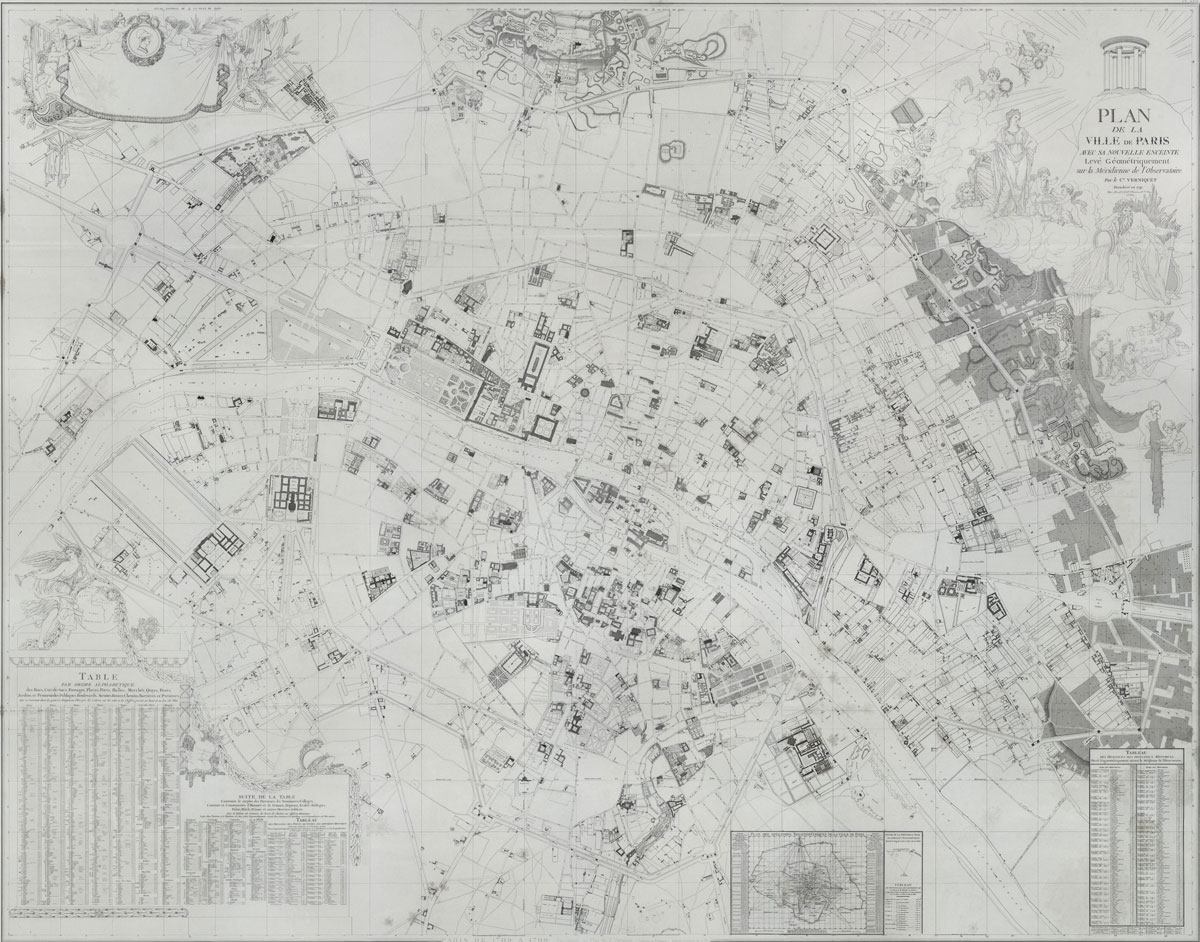
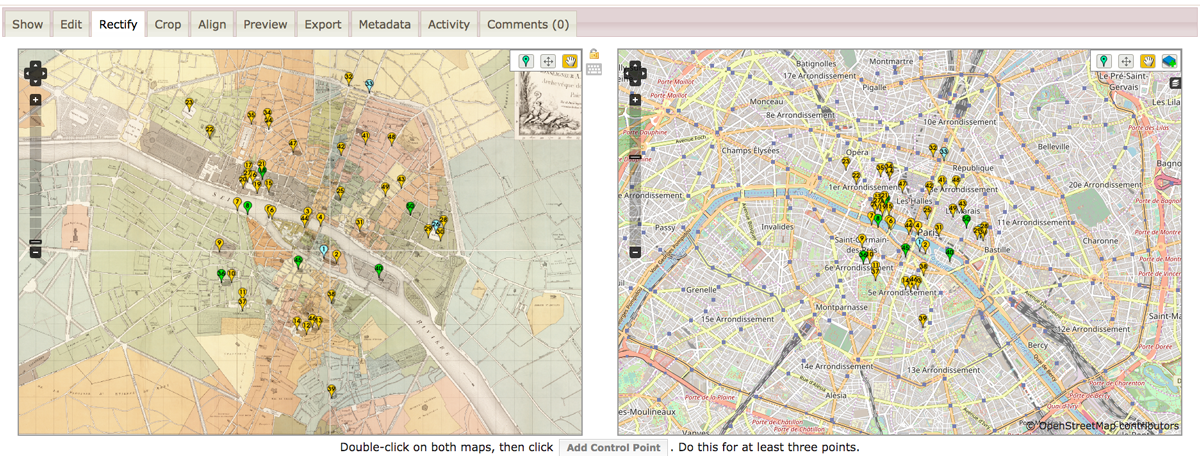
With a database of address information ready to be mapped and georeferenced eighteenth-century maps of Paris, the next stage was to determine coordinates for every artist’s address. One of the most challenging aspects of this part of the process was the vagueness inherent in eighteenth-century addresses. Digital mapping by definition requires precise spatial data—a set of coordinates that drops a marker in an exact spot on a city street—but in this period of Paris’s history, before any system of house numbering existed, the addresses in the Academy’s lists and the Almanachs were often frustratingly imprecise.8 Examples from the Academy’s membership list of 1726 (Fig. 2) suggest the range of relative accuracy that these records permit. At the most precise end of the spectrum are the addresses that use the name of an actual building, such as Charles-Antoine Coypel “in the Galerie du Louvre,” Sébastien Leclerc “at the Gobelins,” Norbert Roettiers “in the Hôtel de la Monnaie,” or Jean Restout “in the Pavillon des Quatre Nations.”9 Though some of these buildings are quite large (the Louvre is equivalent to numerous city blocks), these artists’ addresses are quite well defined. Artists not living in notable buildings like these were usually listed with street addresses. At their most detailed, these addresses comprise the name of the street along with additional information to define the location: like the nearest cross-street (e.g. Jean-François de Troy on “Rue Neuve des Petits-Champs, opposite Rue Vivienne,” or Jean-Marc Nattier living on that same street, but “opposite Rue Royale”); a distinct local building like a church (e.g. Pierre Drevet on “Rue Saint-Jacques, next to the chapel of Saint-Yves”); or some other landmark (e.g. Gaspard Duchange, also on Rue Saint-Jacques, but “near the Saint-Benoît fountain”).10 In some instances, the extra details offered may have been helpful to someone looking for the address in the eighteenth century, but their value now has diminished considerably. Knowing, for example, that Noël-Nicolas Coypel lived on Rue des Deux-Boules “Aux Trois Rois” (presumably the name of a shop or tavern) gives us little to go on, likewise that Louis I Silvestre lived on Rue du Mail “in the home of a wigmaker.”11 Finally, at the most vague end of the spectrum are the addresses comprising nothing more than the name of the street itself: not so problematic if the street was short (like Louis Galloche on “Cloître Saint-Germain-l’Auxerrois”); but quite a mapping challenge if the street was long (like Louis II de Boullogne on “Rue des Fossez-Montmartre”).12
Given the nature of these historical addresses—designed to be interpreted by humans not computers—it was necessary to plot them manually in order to translate the eighteenth-century address into a set of machine-readable coordinates. After exporting a georeferenced version of Junié’s Plan des paroisses to GeoJSON, I determined the most accurate longitude and latitude references possible for each address, depending on the information contained in the original archival record. In some cases, this process involved consulting other historical maps or conducting further research into the history of Paris’s streets to find additional relevant information regarding lost buildings or landmarks.13 Then, by dropping a marker in GeoJSON onto the georeferenced map at the closest point to the described location, I retrieved the map coordinates and added them to the related address entry in the database.14 With the addition of these specific geospatial reference points, all the biographical and demographic information contained in the database could then be displayed as geolocated markers on historical maps of the city.
Creating an online platform for these maps has been the final stage of this project, undertaken in collaboration with Chris Sparks, the web developer who has built the project’s bespoke website using OpenLayers, an open-source JavaScript library for interactive mapping. The principal objective in developing Artists in Paris has been not only to produce a website that supports these maps and their data, but also to create an engaging and intuitive interface through which the rich art-historical narratives embedded in this data can be searched and explored. As an instrument of research, the data-rich maps of Artists in Paris provide an empirical foundation upon which to build more detailed understandings of the histories of artistic communities, artists’ lives and social networks, the role of the city in art production, and urban experience more generally. But the website is also intended as a space for virtual exploration, where the eighteenth-century art world can be encountered in unexpected discoveries during ambling drifts through city streets.
Exploring Paris’s 18th-Century Art Worlds
Within its layers of interactive maps, Artists in Paris contains myriad art-historical narratives—some large and complex, others small and modest; some perhaps crucial, others merely incidental or even trivial. Throughout the research and development process, I have been working with the data retrieved, but also “playing” with the possibilities of the maps and exploring the neighborhoods and spaces that have emerged as intriguing art-world centers. In this section, I want to offer a sense of those explorations in order to articulate the potential findings to be made on the site, either through intentional inquiry or accidental discovery. Perhaps the most persistent revelation of all, however, has been that while these maps certainly provide answers to questions, their principal function may end up being their ability to prompt new inquiries. Through searches that provide evidence of unexpected local connections, intriguing patterns, or perplexing anomalies, the maps and their shifting arrangements of markers are constantly posing new questions that demand further investigation.
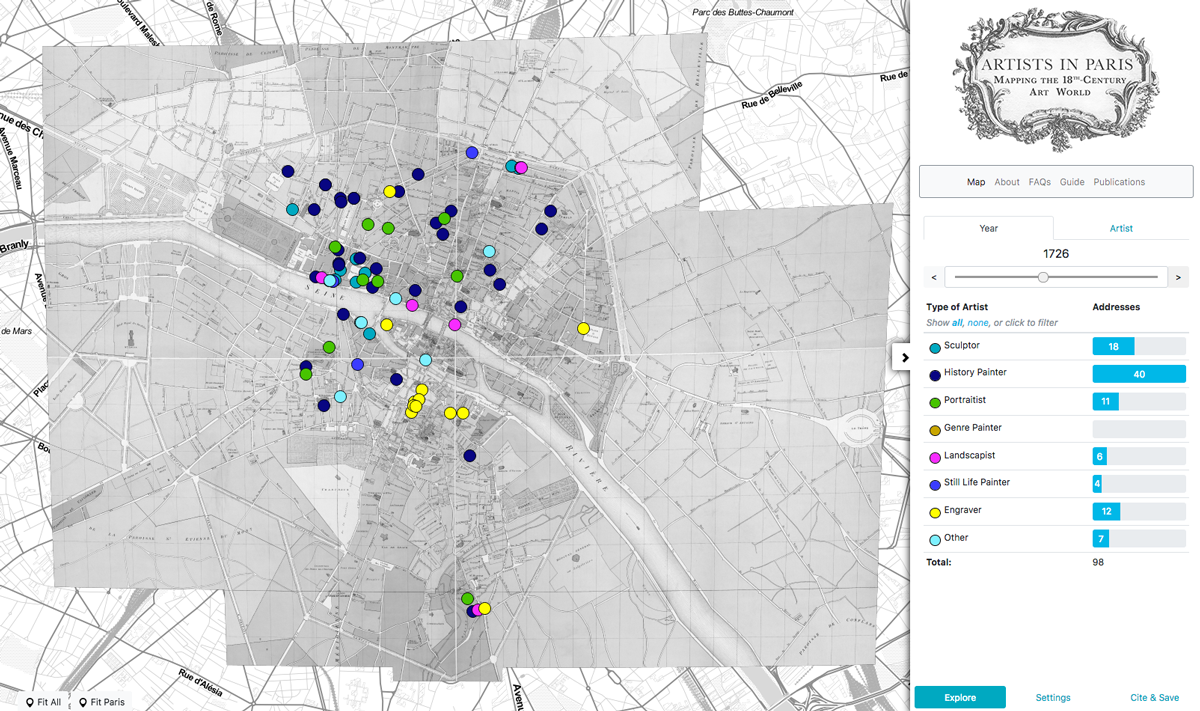
In its beta version, Artists in Paris offers two alternative search modes for exploring the site: searches in year-mode and searches in artist-mode. A search by year displays on the map all the artists’ addresses from that date, as, for example, in the screenshot of a sample search for 1726 (Fig. 8). Compared with its textual source, the Academy’s address list from that year (Fig. 2), the map offers an immediate and compelling sense of the geography of this community, visualized spatially in the distribution of markers across the city. Searching by date permits both focused snapshots like this—revealing the geographic spread of the Academy’s artists and any demographic patterns, clusters, or outliers evident at a single moment—as well as comparisons of shifting populations over time. Observations of change over time are facilitated by the year slider in the navigation panel. Moving the slider forward in yearly increments from start to finish (Clip 1), this mode of interaction presents a view of the big picture geographical and demographic shifts that unfolded between the end of the seventeenth century and the end of the eighteenth century. Among the numerous findings to be drawn from such a search, we might note three key observations. First, that perhaps unexpectedly, the Academy’s artists maintained a significant and extensive spread across Paris throughout the century, inhabiting many different quartiers. Second, that despite the spread, there were also clearly areas of concentration within the city, that is, neighborhoods that seem to have attracted more artists than others. Third, that over the course of the century, one area in particular—the Louvre and its surrounding quartier—grew substantially in its concentration of artists, becoming far and away the most densely populated artistic neighborhood. By the 1770s, as this spatial visualization reveals, the Louvre quarter was home to more than half of the Academy’s artists.

As the Louvre was the location of the Académie Royale from 1692, its centrality for this particular community of artists is not surprising, but the extent to which the palace comes to dominate the demographic narrative is striking. Moreover, as artists had been granted logements in the Louvre by the king since the beginning of the seventeenth century, it is also intriguing to consider why this dramatic shift should have been witnessed in the eighteenth century.15 Along with the arrival of the Academy in the 1690s, the other decisive event in this regard would appear to be the relocation of the French Court to Versailles in 1682, after which the Louvre was left to develop into France’s principal forum for elite cultural and intellectual activity.16 The palace’s transformation is even more evocatively suggested when the same year search is executed with the map zoomed in to the level of the neighborhood (Clip 2). From this perspective, we find a more detailed sense of the changing distribution of the artistic population: from 1675, when there were few artists in the wider neighborhood and all those in the palace were confined to the long Galerie; to the early 1700s, when many more had moved into the streets around the Louvre and a handful had just started occupying spaces in the main palace; to the 1770s, when the artistic takeover of the Louvre was more or less complete, its Galerie and main wings heavily populated by artist inhabitants.
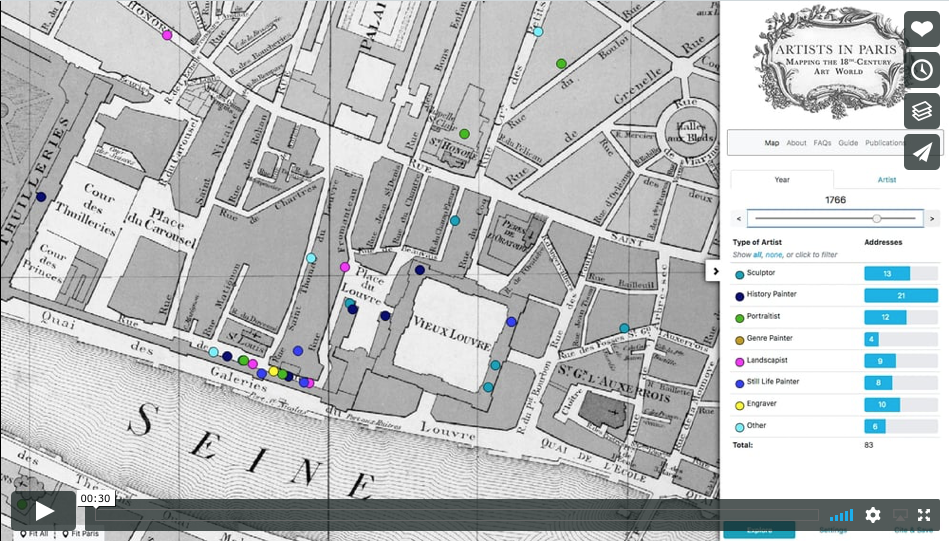
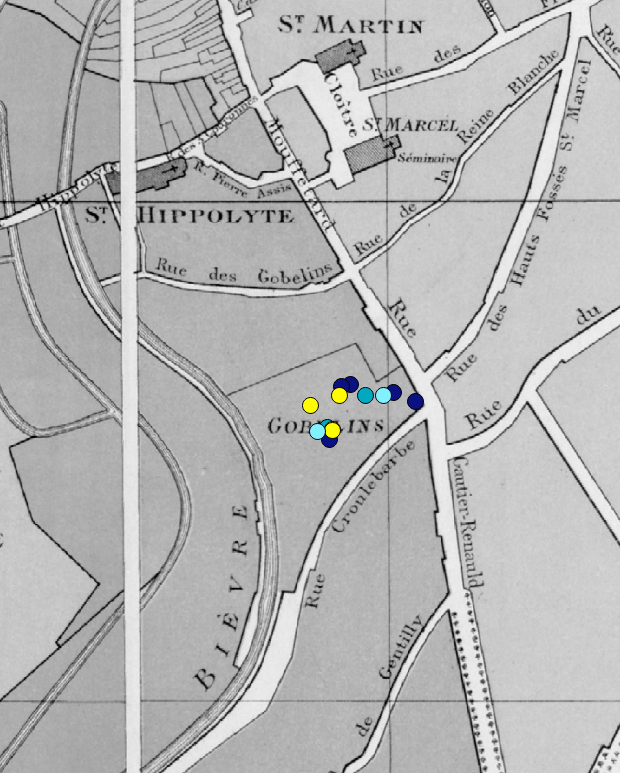
Notwithstanding the Louvre’s increasing force as the epicenter for Paris’s academic artists, year-mode searches also reveal other parts of the city that became artistic neighborhoods. The area around the Palais Royal maintained a strong artistic presence throughout the century, with Rue Neuve-des-Petits-Champs and Rue de Richelieu proving popular addresses. The Faubourg Saint-Germain and the Marais were also usually home to several artists, including a particular concentration at various points up near the Porte-Saint-Martin—especially on Rue Meslay—an area of the city also home to numerous Guild artists. Another artistic neighborhood, particularly notable due to its remoteness, is the community of artists living in the Gobelins tapestry factory (Fig. 9), down on the southern outskirts of the city (near present-day Place d’Italie). The number of academic artists resident in the factory was highest in the later decades of the seventeenth century, but there was a steady if smaller presence throughout the eighteenth century. The mixture of colored markers in the Gobelins—each color representing a different artistic genre or media—also suggests something of the diversity of this community. In 1680 (the year shown in Fig. 9), the Gobelins was home to five history painters, four engravers, two sculptors, a decorative painter, and a battle painter (among the scores of other artisans not shown who were involved in the production of tapestries).17 There is a comparable mixing of marker colors—and therefore diversity of genre/media—in many areas of artistic residence, not least within the corridors of the Louvre, where history painters and sculptors lived alongside portraitists, medal engravers, and still life painters (to name but a few). But elsewhere in the city, we occasionally find clusters of the same colored markers, suggesting the formation of sub-communities by artistic trade.

Most pronounced of any sub-community by media is the enclave of engravers who lived and worked along and around the Rue Saint-Jacques (Fig. 10). As the street at the center of Paris’s book-selling and printing trades, this was an obvious quartier for engravers to make their home and its longstanding identity as a printmaker’s district is well-known.18 But visualizing this collective of engravers on the map within the broader picture of the Academy’s demographic spread begs the question of the impact that such sub-communities had on professional and social networks. In 1740 (the year shown in Fig. 10), there were 15 engravers in the Academy and eight of them were all living within a few blocks of each other. In this little local neighborhood, close-knit bonds certainly formed to bring this group together, as suggested in the numerous intermarriages between engravers’ families, but it is possible that geographic proximity may have also translated into professional unity—a Left Bank engravers’ clique—within the wider academic community.

Another way of seeking out alternative sub-narratives through genre and media is to use the filtering mechanism on Artists in Paris to display only artists of selected types on the map. Isolating artists by genre permits an additional range of more granular inquiries in the year-mode, which might draw out the different socio-economic conditions of artists, or the different requirements of their profession. Searching for portraitists, for instance, it is not uncommon to find them residing in fairly elite neighborhoods, like the area near Saint-Roch and the Rue Saint-Honoré, or in the Faubourg Saint-Germain, placing them conveniently on-hand for the richer clientele most likely to solicit their services (Fig. 11). For portraitists, living in the same streets as their customers was presumably better for business. Sculptors, meanwhile, often lived in quite different parts of the city from their painting colleagues. While many took up residence in the Louvre, there was also a tendency for sculptors to live much farther from the center, often quite close to the city limits (Fig. 12). These quasi-suburban studios presumably had many advantages for them: facilitating the delivery of materials (like marble) from outside of Paris; granting the larger amounts of space their practice required; and in some cases also placing them closer to foundries for metal casting, like that at the Roule out near the Champs-Elysées, which was home to many sculptors over the years including Jean-Louis Lemoyne, Edmé Bouchardon, Augustin Pajou, and Jean-Antoine Houdon.19
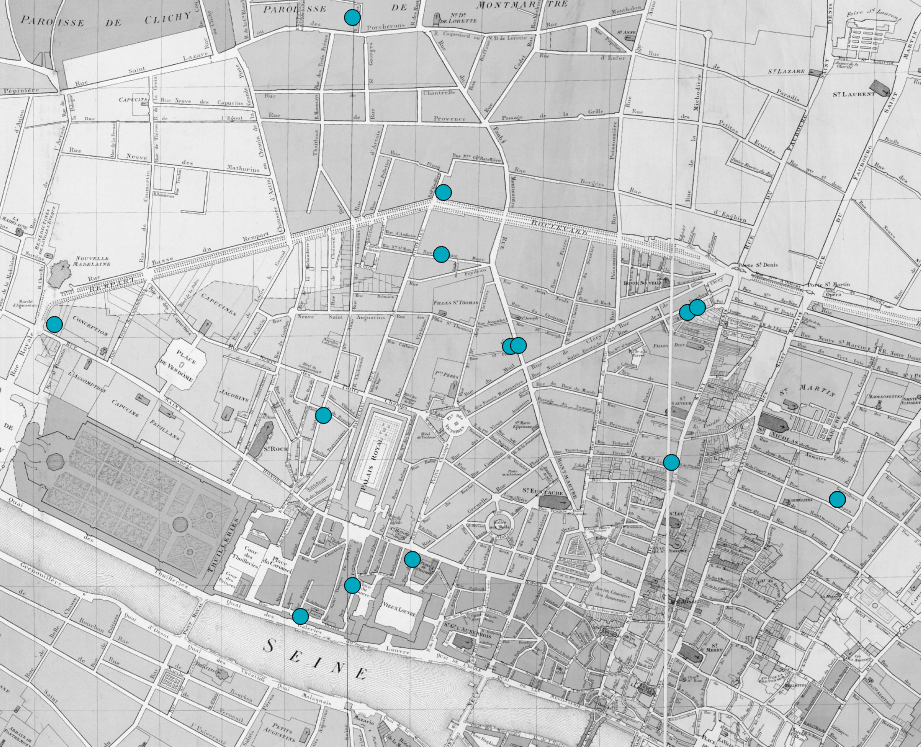
While year-mode searches reveal these larger geographic and demographic patterns, the website’s artist-mode grants access to more personal narratives around individual artists. In artist-mode, the user selects an artist’s name and the map displays all the addresses at which that person lived throughout his or her career. This provides a very different way of accessing the site’s data: rather than offering a spatial visualization of the Academy’s annual address lists, this mode connects all those lists together through common human threads. Following individual artists around the city allows us to draw a map of people’s stories, to trace their trajectories, to observe the trends followed or the quirky decisions made. In some cases, these maps might confirm aspects of an artist’s life already well known, but in others, the hope is that they serve as an enticement to dig deeper into the reasons why—to discover the professional and personal associations, conditions, and events that led to the paths pursued.
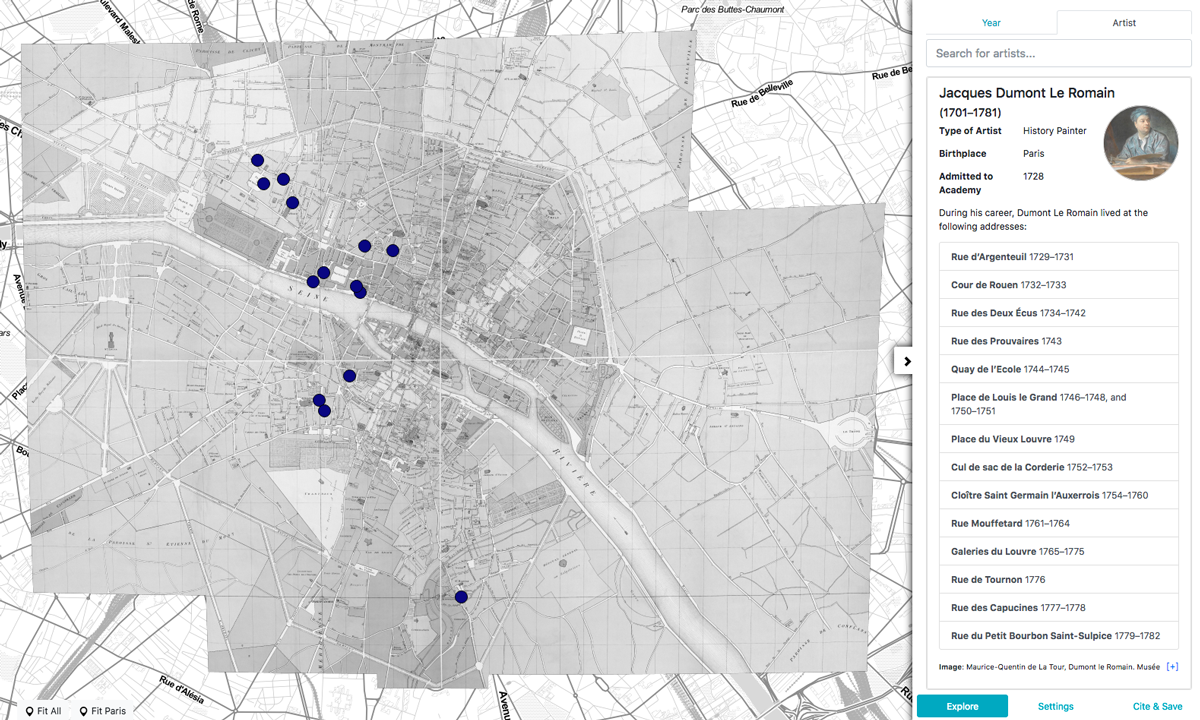
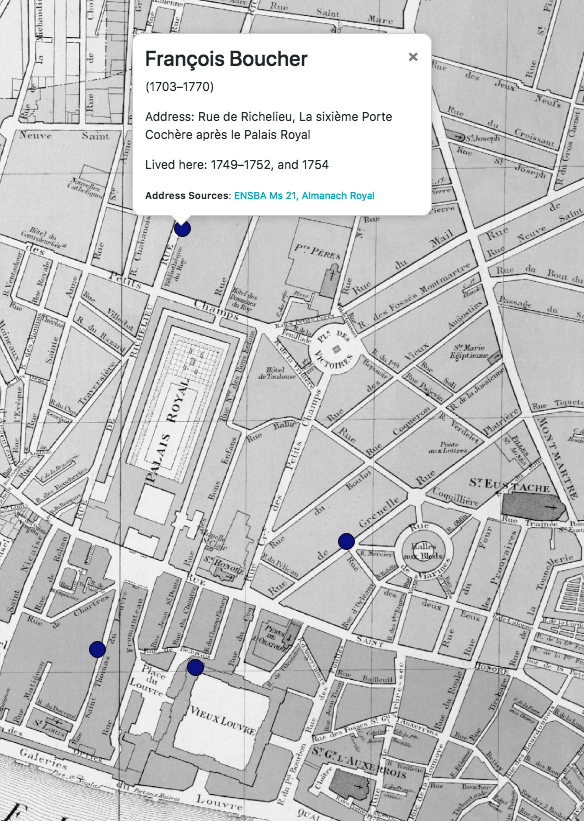
Comparing an individual’s trajectory with those of colleagues, for instance, raises intriguing questions about the relative stability or instability of artists’ professional and domestic lives (the studio and the home being one and the same for most artists in this period). Some artists have only one address throughout their careers, like Charles-Antoine Coypel, who was already living in his father’s Louvre logement when he entered the Academy in 1715, and remained a resident of the palace until his death in 1752. Others, by contrast, look much more itinerant. Jacques Dumont le Romain, for instance, moved fifteen times during his fifty-three-year career, sometimes setting up studios for only a couple of years before moving to a new address (Fig. 13). Artists who relocated sometimes moved to very different parts of the city (like Dumont le Romain, who once moved from Rue d’Argenteuil near Saint-Roch to the Cour de Rouen near Saint-André-des-Arts), perhaps indicating needs or desires to be more conveniently located near particular people or places. But for other artists who relocated, there was a tendency to stay within the same neighborhood (e.g. François Boucher lived at four different addresses all near the Palais Royal and Louvre (Fig. 14)), perhaps suggesting changes in circumstances, like terminations of tenancies, moves to marital homes, or opportunities for improved living conditions.
Looking at the addresses of individuals can also reveal curious details about an artist’s living arrangements. We have already seen that Louis I Silvestre lived in the home of a wigmaker on Rue du Mail, but sometimes domestic trade relations were more synergetic: the medal engraver Jean Duvivier lived for a year with a serrurier (ironsmith) on Rue du Chantre; and the architectural and decorative painter Jacques de Lajoue lived for many years with an orfèvre (goldsmith) on Quai Pelletier. Other artists were dependent on the hospitality of patrons, like Jean-Antoine Watteau, who in 1718 lived with Pierre Crozat in the Faubourg de Richelieu. Sometimes artists can be found living with other artists, sharing domestic space and presumably studio space as well. This was a particularly common arrangement within families: in the 1710s, Jean-Marc Nattier lived with his older brother Jean-Baptiste on Rue Frementeau; and father and son, François and Jean-François de Troy, lived together on Rue Neuve des Petits Champs for over twenty years. Academicians cohabiting was less common outside of families, but not unheard of, as in the case of the sculptor Laurent Magnier, who shared his home with the portraitist Nicolas Heude throughout the 1670s.
Discovering housemates and neighbors offers glimpses into the relationships, collaborations, and networks that wove the social web of the eighteenth-century art world. But just as intriguing in a different way are the artists who intentionally chose to extricate themselves from these social circles by living far away from the rest of their colleagues. Among these outlying anomalies, we find, for instance, the portraitist Jean-Baptiste Perronneau, who, in the final years of his life, moved to an address at “Petit Charonne” in the far reaches of the Faubourg Saint Antoine, near present-day Place de la Nation (still at least an hour’s walk from the Louvre even on today’s surfaced roads). Another artist who chose geographic seclusion was the sculptor Jean-Baptiste Pigalle, who, after a 25-year career living in central Paris in and around the Louvre, moved at the beginning of the 1770s to the far north of the city, right up towards Montmartre.20 His relocation to this almost rural suburban property, with estates that reached the Barrière Blanche of the city’s wall of the Ferme Générale, may have had something to do with his marriage in 1771 to his 20 year-old niece (37 years his junior). Whatever his motivations, Pigalle’s is one of the many stories of artists’ lives plotted on these maps that calls for deeper exploration.
Urban Memory: the Eighteenth-Century Art World in the Streets of Paris
Artists in Paris is a virtual space whose exploration will hopefully prompt as many questions as it answers. While initiated as a project investigating the geography and demography of Paris’s eighteenth-century artistic communities, the stages of research and the processes involved in digital mapping have certainly already opened up many new lines of inquiry through the digitally reconfigured terrain of spatial art history. In this final section, I want to discuss just one of the more unexpected paths I have been led down, by tracing intersections between art history and urban history.
Mapping, as a historical method, reinforces an understanding of the past as something situated, encouraging a consideration of where as much as when. But digital mapping, perhaps more than other methods, strengthens a sense of the shared spatial connections between past and present. Placing georeferenced historical maps over a contemporary base map creates a stratigraphic history of urban space in all those layers of cartographic representations from different moments in the city’s past. Every address plotted on these digital layers therefore resides not only on the eighteenth-century maps above, but is pinned right through to a point in the modern city below, conceptually transcending centuries of urban change to punctuate a shared connection embedded in place. Making these maps, in other words, is quite literally a process of locating the past in the present.
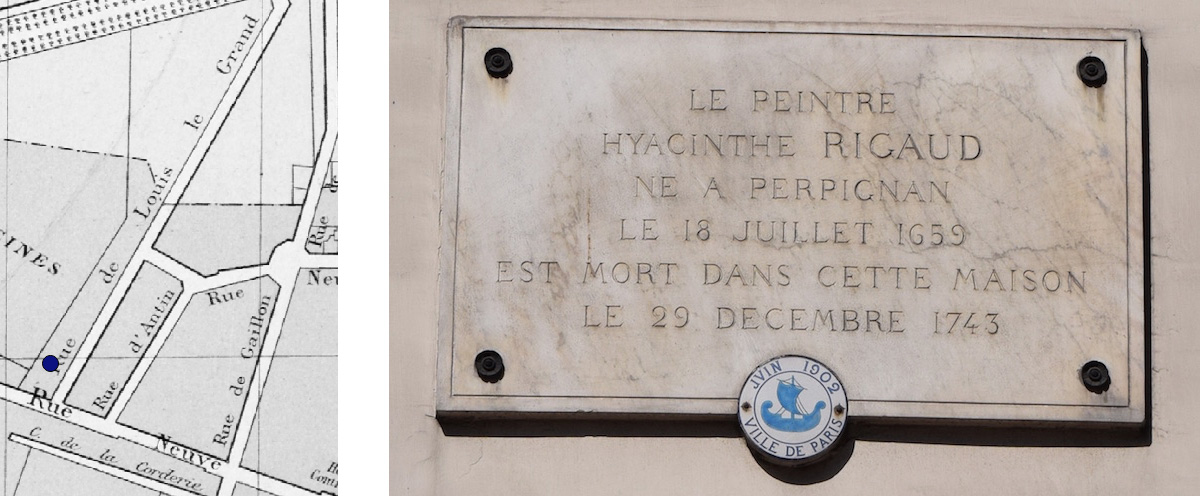
Almost unintentionally, digital mapping thus taps into a psychogeographical impulse to find memories of the past in the contemporary urban environment, to find, in this instance, how Paris’s eighteenth-century art world might be encountered (or not) in the streets of the city today. It is precisely this desire to ‘site’ the past that motivates those ubiquitous urban signs of commemoration, like English Heritage’s Blue Plaques or the Mairie de Paris’s historical shields, which pinpoint in-situ the connections between people and place across time. Only very occasionally, however, in the streets of Paris, does one come across a plaque or any other kind of sign marking a site once inhabited by an eighteenth-century artist. If you turn into Rue Louis le Grand, near Place Vendôme, you will find a large marble plaque above the awning of a café on the wall of the house where the painter Hyacinthe Rigaud lived and died (Figs. 15 and 16). Similarly, walking up Rue de Cléry towards Porte-Saint-Denis, there is a scruffy stone plaque near the door of a building on the left side of the road marking the erstwhile home of the painter Elisabeth Vigée-Lebrun, who lived there for eleven years in the 1770s and 1780s (Figs. 17 and 18). Both of these plaques were set in place at different moments by the Mairie de Paris, but overall there has not been much official effort to commemorate this era of the city’s art world. Browsing the city’s plaques in Open Plaques, a community-based digital history project mapping thousands of commemorative plaques around the world, the majority of the Mairie’s signs instead re-inscribe the city with people and events from its political history, and usually from later periods.21
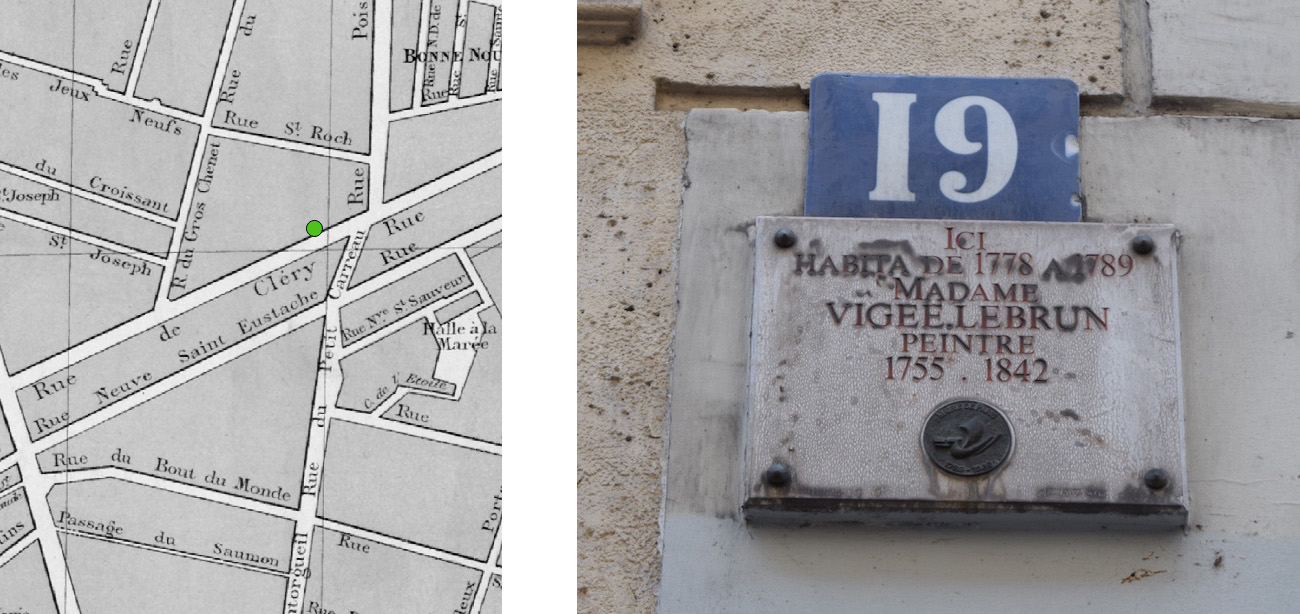
Without official signs of remembering, so many of the streets that formed the densest neighbourhoods of the Paris art world now bear no trace at all of their eighteenth-century inhabitants. Rue Saint-Jacques, the engraver’s hub, and other popular addresses like Rue Neuve-des-Petits-Champs, Rue de Richelieu, or Rue Meslay are now devoid of signs marking their artistic heritage, except occasionally implicitly in their commercial inclinations, like the bookshops and printers still inhabiting Rue Saint-Jacques, or the numismatic inflection to Rue de Richelieu. Even streets that once accommodated some of the period’s most famous names do not announce it: there is no sign of Jean-Baptiste Greuze on Rue des Bourdonnais (known as Rue Thibaudoté when he lived there in the 1770s), and no sign of Jean-Siméon Chardin on Saint-Germain’s Rue Princesse, where he lived for over 30 years. And while many of the royal or state buildings in which artists lived and worked remain standing today—the Louvre, Gobelins, Hôtel de la Monnaie, Arsenal, etc.—it is these buildings’ institutional lives, rather than their domestic ones, which are remembered now in information boards, guides, and commemorative plaques.
| Arrondissement | Street Name | Artist named after | Date named |
|---|---|---|---|
| 9e | Rue Jean-Baptiste Pigalle | Jean-Baptiste Pigalle (1714-1785), Sculptor | 1 Apr 1993 (called Rue Pigalle in 1803) |
| 9e | Place Pigalle | 30 Dec 1864 | |
| 10e | Rue Bouchardon | Edmé Bouchardon (1698-1762), Sculptor | 24 Aug 1864 |
| 13e | Ave Caffieri | Jean-Jacques Caffieri (1725-1792), Sculptor | 23 Aug 1864 |
| 13e | Rue Coypel | Noël (1628-1707) & Antoine Coypel (1661-1722), Painters | 2 Mar 1867 |
| 13e | Rue Le Brun | Charles Le Brun (1619-1690), Painter | 27 Feb 1867 |
| 13e | Rue Oudry | Jean-Baptiste Oudry (1686-1755), Painter | 28 Dec 1894 |
| 13e | Rue Philippe de Champaigne | Philippe de Champaigne (1602-1674), Painter | 2 Mar 1867 |
| 13e | Rue Regnault | Jean-Baptiste Regnault (1753-1829), Painter | 10 Aug 1868 |
| 13e | Rue Watteau | Jean-Antoine Watteau (1684-1721), Painter | 27 Feb 1867 |
| 15e | Rue Vigée-Lebrun | Élisabeth-Louis Vigée-Lebrun (1755-1842), Painter | 18 Apr 1890 |
| 16e | Rue Greuze | Jean-Baptiste Greuze (1725-1805), Painter | 24 Aug 1864 |
| 16e | Rue Jouvenet | Jean Jouvenet (1644-1717), Painter | 24 Aug 1864 |
| 16e | Square Jouvenet | 15 Mar 1957 | |
| 16e | Rue Lancret | Nicolas Lancret (1690-1743), Painter | 24 Aug 1864 |
| 16e | Rue Largillière | Nicolas de Largillière (1656-1746), Painter | 2 Mar 1867 |
| 16e | Rue Mignard | Pierre Mignard (1610-1695), Painter | 6 May 1881 |
| 16e | Rue Pajou | Augustin Pajou (1730-1809), Sculptor | 24 Aug 1864 |
| 16e | Rue Van Loo | Carle Van Loo (1705-1765) and family, Painters | 11 Sep 1869 |
| 16e | Rue Isabey | Jean-Baptiste Isabey (1767-1855), Painter | 2 Mar 1864 |
| 16e | Rue François Gérard | François-Pascal-Simon Gérard (1770-1837), Painter | 2 Jun 1853 |
| 16e | Rue Girodet | Anne-Louis Girodet de Roucy (1767-1824), Painter | 2 Mar 1867 |
| 17e | Rue Fragonard | Jean-Honoré Fragonard (1732-1806), Painter | 10 Feb 1875 |
| 18e | Rue Coustou | Guillaume I Coustou (1678-1746), Sculptor | 23 Aug 1864 |
| 18e | Rue Coysevox | Antoine Coysevox (1640-1720), Sculptor | 18 Apr 1890 |
| 18e | Rue Falconet | Étienne-Maurice Falconet (1716-1791), Sculptor | 13 Jan 1934 |
| 18e | Rue Girardon | François Girardon (1628-1715), Sculptor | 27 Feb 1867 |
| 18e | Impasse Girardon | 3 Sep 1869 | |
| 18e | Rue Houdon | Jean-Antoine Houdon (1741-1828), Sculptor | 24 Aug 1864 |
| 18e | Place Nattier | Jean-Marc Nattier (1685-1766), Painter | 10 Feb 1937 |
Table 1. Streets in Paris named after artists who were members or students of the Académie Royale (1648-1793).
Striking a discordant contrast to this plethora of once inhabited and now unmarked spaces are the numerous signs in Paris that bear the names of eighteenth-century artists and yet have little connection to any actual lived presence. Over thirty Paris streets are named after artists who were once members or students at the Académie Royale (Table 1). But almost none of those artists ever lived anywhere near, let alone on, their eponymous street. When arranged by arrondissement (as in Table 1 or the map at Fig. 19), it is clear that most of these streets probably did not even exist in the eighteenth century, when the city limits only comprised the inner 12 arrondissements.

The explanation behind these eighteenth-century art-world street names in fact leads to a very different moment of Paris’s history. An additional column on the table provides the date of each street’s naming (each linked to its entry in the Mairie de Paris’s digitized records), indicating that most received their names after Napoleon III’s annexation of the suburban Communes in 1859.22 This act of urban expansion absorbed into Paris all the territory between the wall of the Ferme Générale and the later wall of Adolphe Thiers. Forming the new outer arrondissements (13e-20e), this annexation nearly doubled the number of streets in Paris, and many of them needed new names. A committee was formed under Charles Merruau, sécrétaire générale de la Préfecture, to take charge of this huge act of nomenclature. This committee, though not always consistent in its task, set out to create coherence in the city by giving a sense of identity to different neighborhoods, grouping street names in areas by categories.23 In the 7e arrondissement, for instance, home to the École Militaire, several streets were renamed after military and naval figures.24 Meanwhile, many new streets in the 16e were named after painters (e.g. Rue Greuze, Rue Van Loo, Rue Largillière), and many in the 18e after sculptors (e.g. Rue Falconet, Rue Coustou, Rue Houdon). Unfortunately, the committee seems to have recorded few details regarding their reasons for these specific choices.
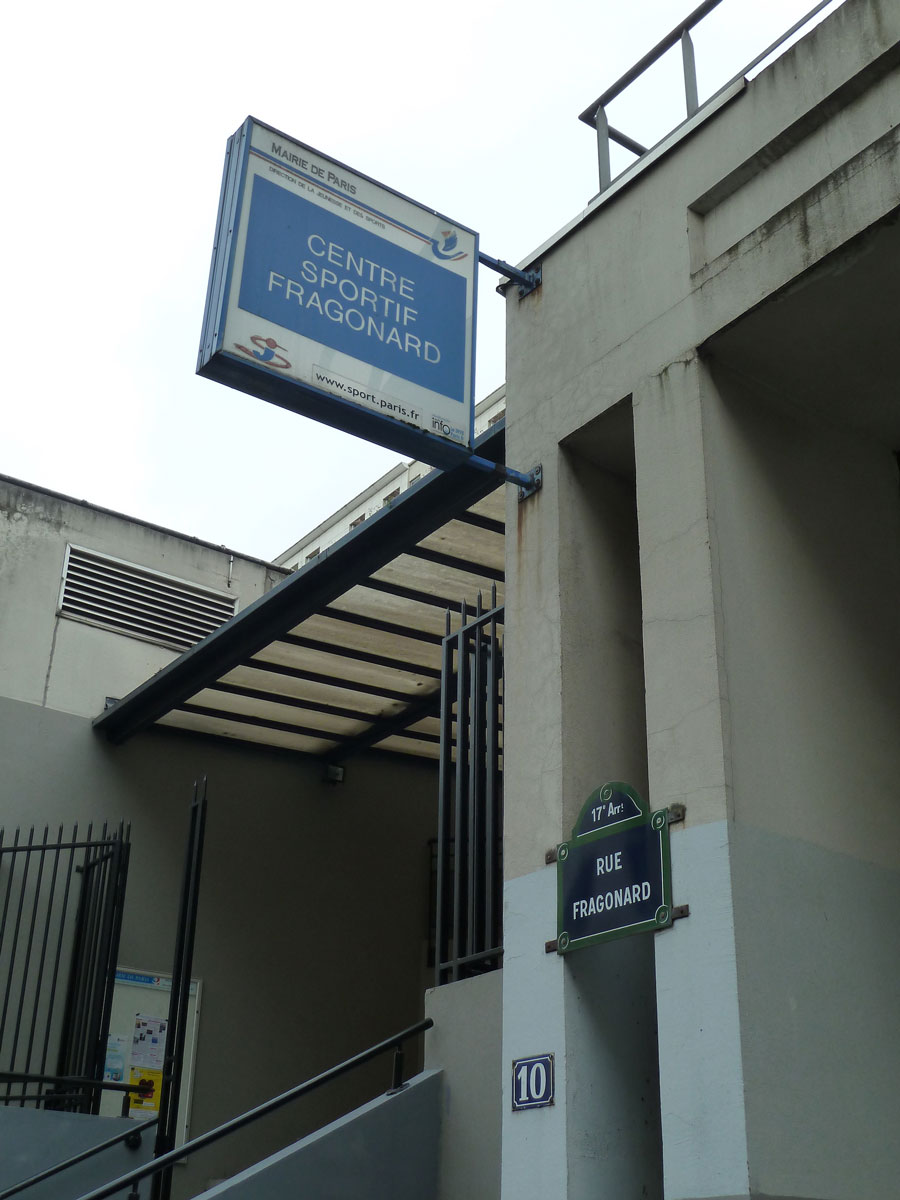
When walking through the city now, this history-by-committee can lead to some incongruous encounters. Perhaps foremost among them, the brutally non-descript Rue Fragonard (Fig. 20), complete with a municipal sports center, out near the Périphérique in the 17e, or the inauspicious Rue Vigée-Lebrun in the 15e, on the other side of Paris from her Rue de Cléry home, and mostly notable (or un-notable) for its blocks of 1970s apartments. In other places, however, the synergies are more resonant. With the modernist artistic associations of Montmartre, streets named after eighteenth-century artists in the 18e arrondissement seem harmonious despite their inaccuracy. It is almost fitting, for instance, to find the Moulin de la Galette, that famous Impressionist haunt, on the corner of Rue Girardon (Figs. 21 and 22).

Most striking of all, however, are the rare moments when these Paris street signs actually do mark memories of place. Many of those in the 13e arrondissement, for instance, are located near the Gobelins (Rue Coypel, Rue Oudry, Rue Watteau, Rue Philippe de Champaigne), recalling not only the tapestry factory’s role in the art world, but also the neighborhood’s role as a space of artistic sociability. Even here, however, only one of these streets is named after an artist who actually lived at the Gobelins (Rue Le Brun), though several did have professional associations with the tapestry works. A similar not-quite connection takes place with Rue Bouchardon in the 10e, just behind Porte Saint-Martin, an area where Edmé Bouchardon never lived, but where many other Parisian sculptors did. The only real direct confluence of sign and site is to be found in the 9e arrondissement, where Rue Jean-Baptiste Pigalle (Fig. 23), Place Pigalle, and Pigalle Metro station (Fig. 24) are all on the land that was once part of Pigalle’s property, stretching from Rue Saint-Lazare to the wall of the Ferme Générale, now the boulevard upon which Place Pigalle and its Metro station are located.
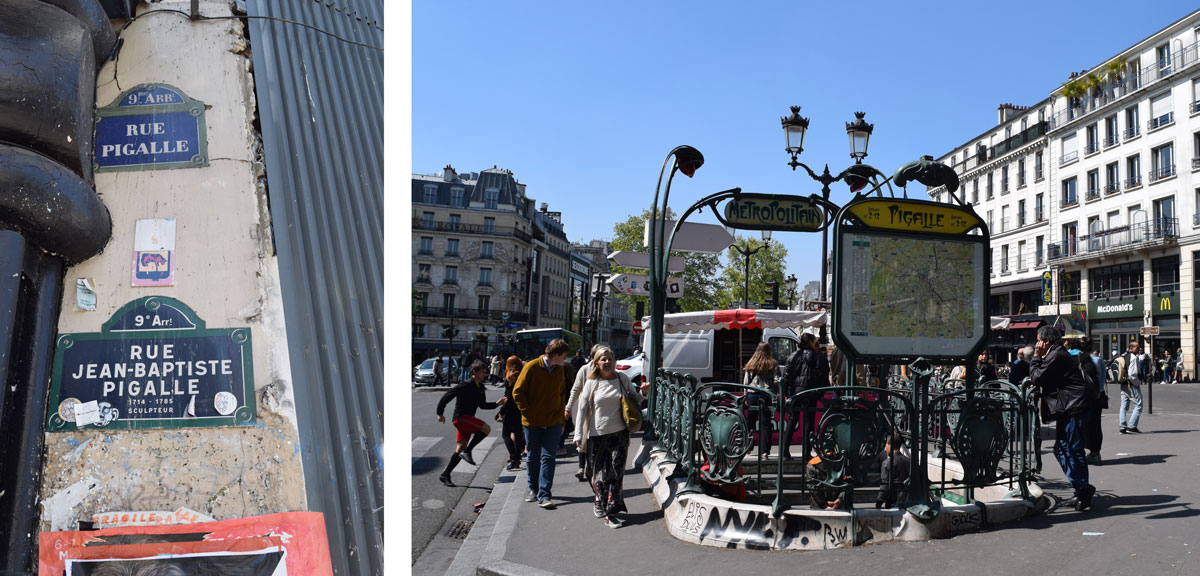
Pigalle’s name also lends itself colloquially to the Parisian quartier around this square, which is the ideal place to end this article’s excursion into Paris’s artistic urban history. Pigalle (the place) not only forms a resonant intersection between the eighteenth-century art world and the contemporary city, it also draws us back, or forward, into the modernist art-historical chapter that came in between. Pigalle’s somewhat dubious reputation now is at the heart of Paris’s touristy red-light district (complete with eponymous nightclubs like the Pigallion, Le Rouge Pigalle and Folies Pigalle), but in the nineteenth century this was an art-world center. When Pigalle lived here in the 1770s, he had been on the outskirts of the city far from his colleagues, but a hundred years later, the street named after him was an artistic thoroughfare, situated geographically between Saint-Lazare station and the foot of the Butte Montmartre. At different moments, Rue Pigalle itself became the home or studio address of numerous artists including Thomas Couture, Pierre Puvis de Chavannes, Claude Monet, Jean-Édouard Vuillard, Pierre Bonnard, and Maurice Denis.25
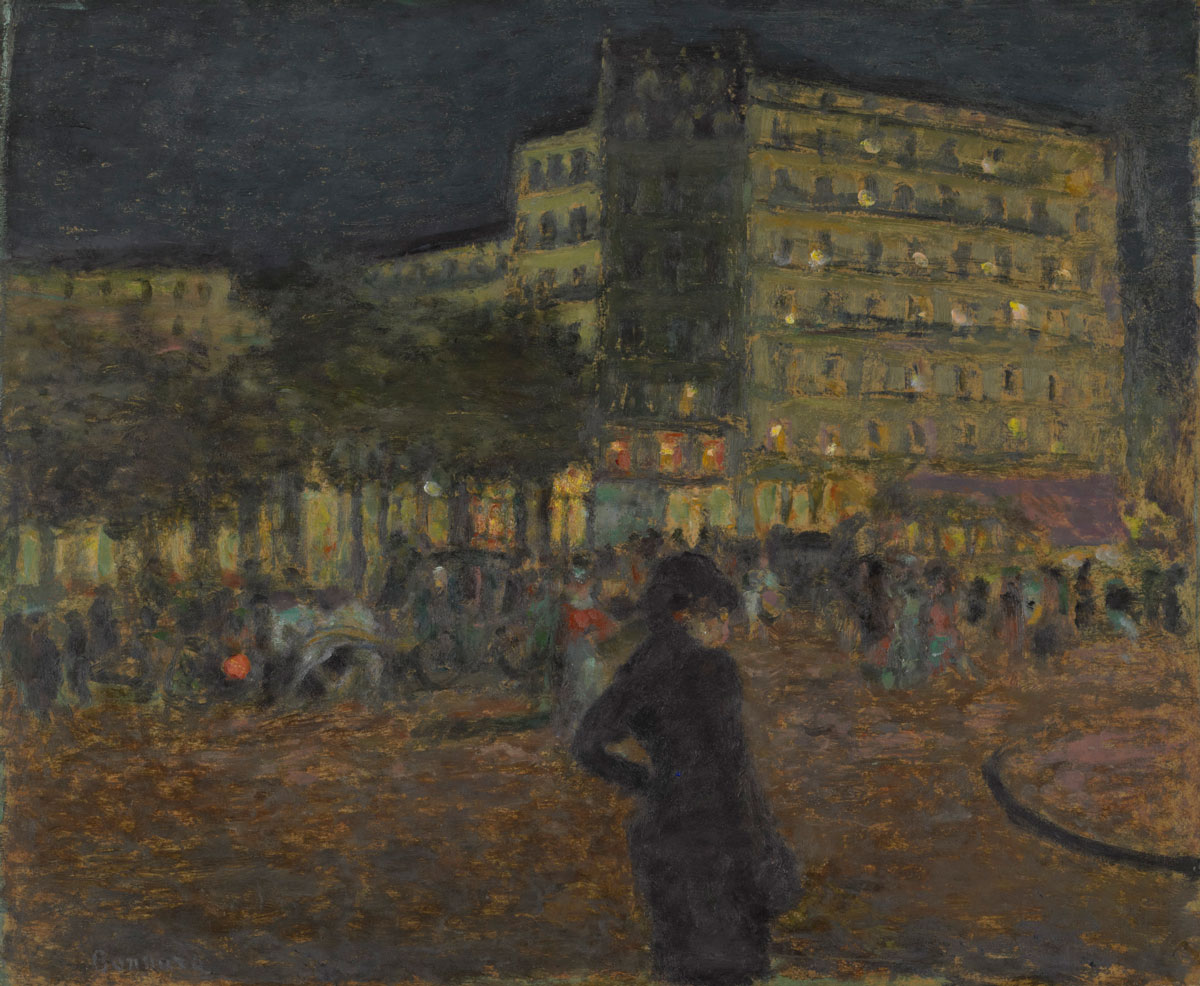
These layers of artistic intersections over time make Pigalle a particularly poignant art-world lieu de mémoire. Its status as a point of connection and continuity in Paris’s art history is inadvertently captured in Bonnard’s Place Pigalle at Night (Fig. 25): a modernist’s depiction of his own neighborhood, once inhabited by an eighteenth-century artist, whose presence lingers in its name. It is precisely works like Bonnard’s Place Pigalle—local artistic engagements with urban spaces—that helped steer the course of nineteenth-century art history in the direction of the city. I hope to have shown in this article a fruitful direction for the field of eighteenth-century art history. Notwithstanding its innovations, a work like Bonnard’s Place Pigalle is, after all, part of much longer narratives extending back to the eighteenth-century Parisian artists who came before, whether geographically (like Pigalle) or artistically, like Debucourt, with his painting of Rue Frementeau (Fig. 1), and all the other eighteenth-century artists who began engaging with urban space as a subject of representation. The point here is not to pit one art world (or one art-historical field) against the other, but rather to find, in the urban spaces of Paris, those connected and continuous histories of which they are all a part. Making the city—that enduring material palimpsest of a historical document—into the focus of the inquiry inevitably dissolves the sometimes rigidly periodized art-historical boundaries set in place by differing methodological approaches. Indeed, that is the refreshing consequence of the digitally mapped urban art history pursued in Artists in Paris.
Hannah Williams is Leverhulme Early Career Research Fellow in the School of History at Queen Mary University of London
Cite this article as: Hannah Williams, “Artists’ Studios in Paris: Digitally Mapping the 18th-Century Art World,” Journal18, Issue 5 Coordinates (Spring 2018), http://www.journal18.org/2654.
Notes
Acknowledgements: Research for this article and for the digital project was funded by The Leverhulme Trust. Thanks are due to Chris Sparks for his invaluable collaboration on the Artists in Paris project. Thanks also to Nancy Um, Carrie Anderson and the Journal18 peer reviewers for their insightful comments on this article.
- The most comprehensive study of artistic neighborhoods in modernist Paris is John Milner, The Studios of Paris: the Capital of Art in the Late Nineteenth Century (New Haven and London: Yale University Press, 1988), but the city has been a crucial site for the field more generally. ↩
- On digital mapping and the spatial turn in historical research and other humanities fields, see David J. Bodenhamer, John Corrigan, and Trevor M. Harris, eds., The Spatial Humanities: GIS and the Future of Humanities Scholarship (Bloomington and Indianapolis: Indiana University Press, 2010). ↩
- For a comparative analysis of the demographics of Academy and Guild artists in a single year, see Hannah Williams, “Artists and the City: Mapping the Art World of 18th-Century Paris,” Urban History (forthcoming). For a mapping project about commercial sites in Paris’s art world, see Charlotte Guichard, Mélanie Ludwig, and Julien Wylleman, “Paris, 1800. Places of the art market,” http://www.artmarkets.eu/visualisations/paris-1800-les-lieux-du-marche-de-lart/?lang=en (accessed November 7, 2017). For a mapping project about exhibitions and display, see Béatrice Joyeux-Prunel’s Artl@s, http://artlas.ens.fr/en/database-2/. On the locations of picture restorers, see Noémie Étienne, The Restoration of Paintings in Paris, 1750-1815 (Los Angeles: Getty Publications, 2017), 147, 282-295. ↩
- École nationale supérieure des Beaux-Arts (ENSBA), Ms 21. Sets of the Almanachs Royaux and the later Almanachs Nationaux are held at the Bibliothèque nationale de France, Paris. Among the gaps in the data are the years 1711 and 1712 (inexplicably omitted from the Academy’s membership register), and the year 1792, which was lost in the change to the Republican calendar. ↩
- Many of the methods in the following stages (for example, using Map Warper for georectification, and GeoJSON for plotting data), were adapted from the invaluable digital mapping tutorial for historians available through New York Public Library Labs: Mauricio Giraldo Arteaga, “From Paper Maps to the Web: A DIY Digital Maps Primer,” NYPL Labs, https://www.nypl.org/blog/2015/01/05/web-maps-primer (accessed Nov 1, 2017). ↩
- For an overview of different georectification and georeferencing approaches, see Christopher Fleet, Kimberly C. Kowal and Petr Pridal, “Georeferencer: Crowdsourced Georeferencing for Map Library Collections,” D-Lib Magazine 18:11-12 (November/December 2012), http://dlib.org/dlib/november12/fleet/11fleet.html (accessed November 7, 2017). ↩
- On the history of Paris city maps and their increasing cartographic accuracy, see Pierre Pinon and Bertrand Le Boudec, Les Plans de Paris: histoire d’une capitale (Paris: Bibliothèque nationale de France, 2014). ↩
- On the history of house numbering, see: Anton Tanter, “Addressing the Houses: the Introduction of House Numbering in Europe,” Histoire et Mesure XXIV:2 (2009), 7-30; and Vincent Demis, “Les Parisiens, la police et les numérotages des maisons, du XVIIIe siècle à l’Empire,” French Historical Studies 38:1 (2015), 83-103. ↩
- Academy’s membership list from 1726, ENSBA, Ms 21. ↩
- Academy’s membership list from 1726, ENSBA, Ms 21. ↩
- Academy’s membership list from 1726, ENSBA, Ms 21. ↩
- Academy’s membership list from 1726, ENSBA, Ms 21. ↩
- Useful surveys of the history of Paris’s streets include: Jacques Hillairet, Dictionnaire historique des rues de Paris, 2 vols. (Paris: Éditions de Minuit, 1963); and Félix Lazare and Louis Lazare, Dictionnaire administratif et historique des rues de Paris et de ses monuments (Paris: Chez Félix Lazare, 1844). ↩
- In the few instances where it was not possible to find any further information about an artist’s address other than the street name, the marker was placed in the middle of the street. ↩
- On the Louvre as a space of artistic sociability, see Jules Guiffrey, “Logements d’artistes au Louvre,” Nouvelles Archives de l’art français (1873), 1-221; Yvonne Singer-Lecocq, Quand les artistes logeaient au Louvre: 1608-1835 (Paris, 1986); and the issue devoted to this aspect of the Louvre’s history: “Louvre Local” Journal18 Issue 2 (Fall 2016), http://www.journal18.org/past-issues/2-louvre-local-fall-2016 (accessed November 7, 2017). ↩
- I address the impact of Versailles on the Louvre’s development in “The Other Palace: Versailles & the Louvre,” a paper delivered at the Enchanted Isles, Fatal Shores: Living Versailles conference at the National Gallery of Art, Canberra, March 2017 (accessed November 7, 2017). ↩
- On the artistic community residing at the Gobelins, see Jules Guiffrey, Histoire de la tapisserie (Tours: Alfred Mame et fils, 1886), 337-373; Jules Guiffrey, Les Gobelins et Beauvais (Paris: Librairie Renouard, 1907); and Florian Knothe, The Manufacture des meubles de la couronne aux Gobelins under Louis XIV: A Social, Political and Cultural History (Turnhout: Brepols, 2017). ↩
- On the community of engravers inhabiting Rue Saint-Jacques in early modern Paris, see Marianne Grivel, Le commerce de l’estampe au XVIIe siècle (Geneva: Droz, 1986), 59-62. ↩
- On the foundry at the Roule and the sculptors who lived there, see Geneviève Bresc-Bautier, “Fonderie et ateliers du Roule,” in Béatrice de Andia, ed., La Rue du Faubourg Saint-Honoré (Paris: Délégation à l’Action Artistique de la Ville de Paris, 1994), 372-377. ↩
- Before his move to the north, Pigalle also lived for three years out at the Roule. On Pigalle’s property near the Barrière Blanche, see Louis Réau, J.-B. Pigalle (Paris: P. Tisné, 1950), 29. ↩
- According to Sauber’s calculations, 658 of the 1553 plaques (in 1993) were connected to World War II alone. M. Sauber, “Traces fragiles: les plaques commémoratives dans les rues de Paris,” Annales: Économies, Sociétés, Civilisations 48:3 (1993), 715-727. ↩
- For the digitized archive of street names produced by the Mairie de Paris (accessed 13 Apr 2017). ↩
- On the committee and its deliberations, see Florence Bourillon, Changer les noms des rues de Paris: La Commission Merruau – 1862 (Rennes: Presses Universitaires de Rennes, 2012). ↩
- Bourillon, Changer les noms, 194-196. ↩
- The nineteenth- and twentieth-century artists’ studios are noted in S. Buisson and C. Parisot, Paris Montmartre: A Mecca of Modern Art, 1860-1920, trans. M. Wyllie (Paris: Terrail, 1996), 199-201. ↩